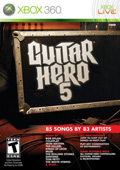 When GameFly sent me Guitar Hero 5 instead of all the other more exciting games ahead of it in my queue, I grimaced. Badly. Activision has been busily bloating the market with an exasperating number of entries in the fake plastic rock genre lately, what with Guitar Hero 5, Guitar Hero Metallica, Guitar Hero Van Halen, Band Hero, DJ Hero, and probably some others I’ve blocked out. And Harmonix hasn’t helped with Rock Band: The Beatles and Lego Rock Band.
When GameFly sent me Guitar Hero 5 instead of all the other more exciting games ahead of it in my queue, I grimaced. Badly. Activision has been busily bloating the market with an exasperating number of entries in the fake plastic rock genre lately, what with Guitar Hero 5, Guitar Hero Metallica, Guitar Hero Van Halen, Band Hero, DJ Hero, and probably some others I’ve blocked out. And Harmonix hasn’t helped with Rock Band: The Beatles and Lego Rock Band.
But then it occurred to me that I hadn’t played any new fake plastic rock games since Rock Band 2, and I wanted to see some of the enhancements to the game that Activision’s otherwise “punch the consumer in the throat” model has afforded them. I was actually really impressed by the enhancements, and I think it’s safe to say that track list aside this is the best music game I’ve ever played. Developers Neversoft have cleaned up the interface vastly, and gone is the awful, deformed art style that I hated so much in Guitar Hero 3. The game looks great, with more realistic yet visually interesting character models and the ability to create your own band members. The fist thing I did was recreate my band “Pavlov’s Cat,” and start plugging away at the set list.
The other really big thing that I like about Guitar Hero 5 is that they added a variety of song-specific challenges to the career mode. One song, for example, might challenge you to hit a certain number of hammer on/pull offs on guitar, while another song might ask you to only strum upwards on bass while a third song asks you to nail a certain number of phrases on vocals. There are three levels to these challenges –gold, platinum, and diamond– and beating them unlocks stuff. This adds a lot of incentive to go back and play around with the songs, especially since some of them require playing on higher difficulty levels or to play with other band members.
There are also a lot of other small changes that make total sense and that reveal a “let’s make everything as convenient as possible to the player” design philosophy. You can easily switch between guitar and bass, for example, and you can change the difficulty level of a song without backing all the way out to the song select screen. Other players can drop right in and out of songs, too, and the navigation is generally really easy.
Unfortunately the only thing I really didn’t like about Guitar Hero 5 is the set list, which coincidentally is by FAR the most important thing about a music game. Even though Neversoft made the “Thank GOD!” move of having no songs unlocked in Quickplay mode, there were maybe two or three songs in there that I actually really liked. This is where Rock Band’s focus on DLC ultimately proves to be much more consumer friendly even if they don’t put out as many new iterations of the game engine. I have hundreds of songs in my Rock Band DLC catalog, and hundreds more that I could go buy for $2 a pop if I want them. And by offering a huge catalog with weekly releases I can make sure that the vast majority of the music I have to play is stuff that I really like.
So Guitar Hero 5 is a better game mechanically, but the business model Activision and Neversoft have pursued here still makes it second fiddle. I sent it back to GameFly without buying it or any DLC songs for it.
Published by